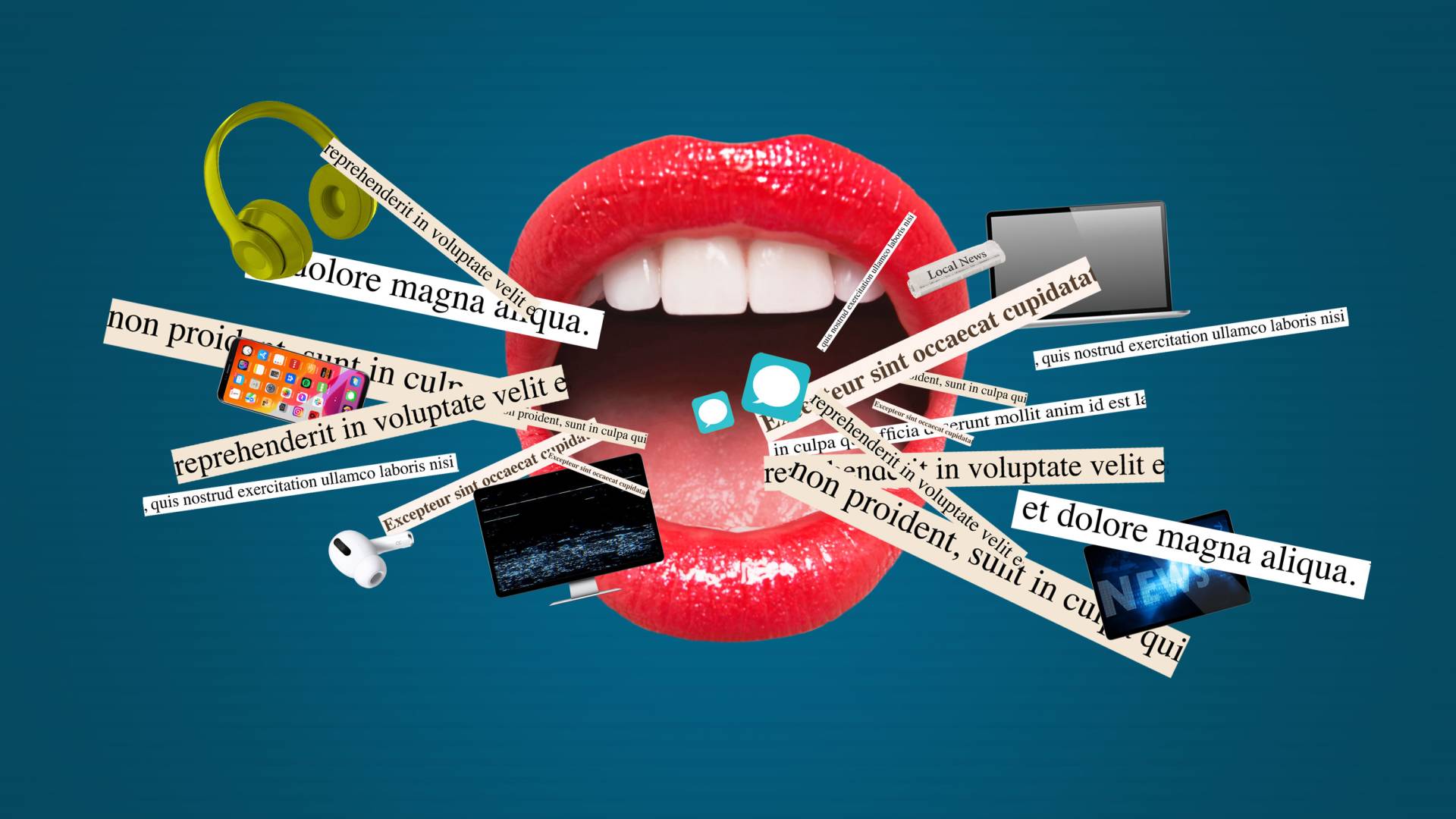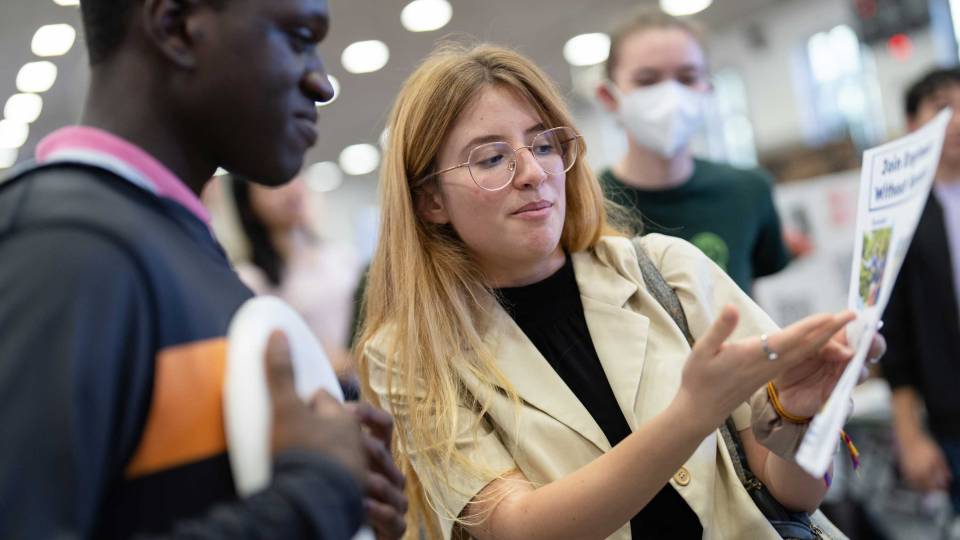Joe Stephens, who spent years as an investigative reporter for the Washington Post, likes to tell a joke on the first day of class to students in his course, “The Media in America: What to Read and Believe.” Cribbed from a famous talk by novelist David Foster Wallace, the joke goes like this:

Joe Stephens
“In the morning, two fish come out of their house and they're swimming across the ocean. An older fish comes along, tips his hat and says, ‘Mornin’ boys, how's the water?’ The two young fish nod and keep swimming. When they get a block away, one young fish turns to the other and says, ‘What’s water?’”
“Water is like the media today: It’s so ubiquitous, we can't even see it,” said Stephens, founding director of the Program in Journalism. “There's an onslaught from the moment we wake up until the moment we go to sleep. It's in newspapers, it's on websites, apps, your phone, your watch. It's everywhere, so much that we don’t even realize that we're consuming media. Or, that the media is consuming us.”
By the end of the course, Stephens wants his students to see the water.
“I want them to see all these invisible things that are influencing their thinking, which are all around them, all the time. Then I want them to come up with a system for themselves, how to manage it, to filter it, to understand it and draw meaning from it. Rather than just passively letting all this stuff consume them,” he said.
Below, Stephens draws on the strategies he discusses with students to offer six tips for remixing your own personal media stream — and weighs in on what it means to be a responsible consumer of media in this moment.
1. Keep a media diary for 48 hours.
“I have my students do this, and one of the conclusions they often make is that they're consuming so much media that they can’t even keep a complete log of it,” Stephens said. “It’s so overwhelming you can't keep track of it, and yet you don't think about the media you’re consuming.”
At the end of the exercise, students undertake a deep analysis of the findings and contemplate whether any changes are in order.
Here’s how to go about it yourself:
- For 48 hours, write down everything you consume. Absolutely everything is the goal. Take notes in real time.
- Be creative and inclusive beyond just journalism about what comes at you. Media includes newspapers (in print, online or in apps), TV and radio (broadcast and podcasts), YouTube, social media. Include background music in a store, posters you walk by, slogans and logos on sweatshirts, entertainment, celebrity gossip, sports, everything.
- Consider how it arrives. Do you read and view primarily on your phone, laptop, TV or an actual newspaper? Is it in aggregate newsletters in your email every morning or on an Instagram or Twitter account you follow?
- Note where it comes from. How much comes from a journalism organization? From an entertainment network? From someone or a political party with an agenda?
- Note how you consume it. Do you listen to it? Do you read headlines alone, the tops of articles or the whole enchilada?
- Note whether it’s hard news or soft, breaking news or in-depth analysis, opinions or fact.
- Note whether it comes at you actively or passively. Does it just pop up as you’re swiping through or is it something you’re going out and looking for?
2. Exercise your rights as a responsible media consumer.
“After my students create their media diaries, that opens a discussion about democracy,” Stephens said. “We’re lucky enough to live in a democracy right now. We own the country, in theory. We run the government, in theory. As individuals and collectively, how do we exercise our rights as good citizens if we don’t have good information, if we don't know what's going on? It would be like flying a 747 without a manual.”
Some actions to help you navigate:
- As a responsible media consumer, decide what information you put in your head.
- Seek out substantial, trustworthy, verified information, alongside all the stuff that’s simply entertaining or silly. “That’s what I strive for, to fulfill my duties as a citizen of a democracy,” Stephens said. “My news feed includes The Morning newsletter from The New York Times, the homepage or apps for The New York Times, Washington Post, Wall Street Journal — serious news organizations that do the reporting themselves and verify facts. Then I mix it up — partly because I teach this stuff, I go to Fox, MSNBC, CNN. I read The New Yorker and the Atlantic, but I also try different things.”
- Statistics show that most of the news is getting to people through social media, more than any other vehicle. The key to being a responsible media consumer is to think about where the news on your social media feed comes from originally. “Ask yourself: Who produced it and why?” Stephens said. “And is someone, somewhere along the food chain working to verify the facts?”
3. Create a ritual for media consumption.
“My father, who didn’t finish high school and rarely cracked a book, would get home from the factory each evening and immediately grab the Cincinnati Post out of the driveway,” Stephens said. “That was his Princeton, his university for the working man. He read every word and took notes in the margins. In the morning, he listened to the radio news.”
The critical point here: “He decided he was going to devote part of his day to getting verified information. That was a ritual,” Stephens said. “He and my mom started and ended their day with journalism they trusted. They were making a conscious decision.”
That’s rarer these days, and it’s why so many of us feel so overwhelmed by our news feeds, Stephens noted. Today, “the media is just there, it's in your face and in your brain.” To counter that:
- Make a ritual and stick to it religiously so it becomes part of you.
- Choose a time of day for consumption of carefully substantiated journalism, “what I call the ’meat and potatoes,’” Stephens said. “Just like in your food diet, don’t snack all day long. At some point you want a meal of nourishing information. It could be when you first wake up, it could be right before you go to bed, or over lunch. You decide.
- Set a length of time for this ritual. “That’s also an antidote to doomscrolling,” Stephens said. “You’re not taking in everything, and you’re not taking in nothing. It's saying, "For 20 minutes at this time of the day, I'm going to check stuff out that’s good for me." It's grounding that you're spending a certain amount of time getting verified information. Then, if you want to go through Reddit, TikTok, Facebook or Instagram, just because it's fun, do it.”
- Be intentional about your ritual selections. “For me, signing up for a daily newsletter like The Morning is like having the newspaper dropped on my stoop,” Stephens said. “An app like NPR One lets you seamlessly listen to the latest news and audio stories from around the world, and from your local public radio station, all squeezed into a few minutes in the morning.”
4. Pay attention: Learn to distinguish between journalism and everything else.
These are some questions Stephens urges his students to ask to help parse out whether a story is trustworthy journalism, unreliable information or disinformation. The questions center on what he calls “the three-legged stool of journalism”: sources, direct observation and documents/data.
- What human sources were used in the reporting? “That's where most stories come from,” Stephens said. “If a human isn’t named in a news account, your antennae should go up.”
- Are sources identified by name and affiliation/expertise? Do they have a Ph.D. in whatever they’re talking about or life experience that makes their point of view relevant and well-informed? Do they have obvious biases or financial conflicts of interest?
- Does the story include direct observation? “Was the journalist in Kabul and saw the car bomb go off?” Stephens asks. Or is what’s being reported hearsay?
- What documents or data are used to back up the story? Are the documents made readily available on the web? “Typically, a document in an investigative story was created for a purpose unrelated to the story that you're reading, so it would be hard to falsify,” Stephens said.
5. Include ‘iron core’ stories in your media diet.
“I talk with my students about the huge world of journalism — the op-eds, the features, the profiles of people in the news,” Stephens said. “But at the center, there's a small kernel that's referred to as the iron core.” Pulitzer Prize-winning journalist Alex S. Jones describes this core as the serious news reported firsthand by news organizations — ones dedicated to ensuring their facts are checked and presented in context. Inside that core is so-called hard news — verified accounts of what’s happening at the White House, in Afghanistan, in Ukraine. Inside is explanatory journalism and accountability reporting. And the iron core also includes deep investigative reporting, where someone or a team has spent great effort and a great amount of time to uncover stories like The New York Times’ #MeToo coverage of Harvey Weinstein.
- “It can take months, even years to dig this stuff out, to verify facts, to run it through lawyers, to get it out there. It's expensive, and it takes people who are very skilled at doing it,” Stephens said of investigative reporting. Think about what percentage of your media diet is iron core reporting -- stories where the writer personally authenticated the details and explains how they did so -- and seek it out. These stories may appear in any serious journalism outlet, from the Wall Street Journal to the BBC to the website of ProPublica. Try to make such reporting a substantial percentage of what you consume.
- “When you look closely, as my students do, often you’ll find you are reading a second- or third-hand account,” Stephens said. “The Washington Post breaks a big story, but often you will be reading about it in The New York Times. Like a game of telephone, the farther you get from the original account, the less reliable it becomes.”
- If you read in a story, "… as first reported in the Atlantic," stop reading and go to the original account. There's often a hyperlink to the original source.
6. Diversify voices and perspectives.
Stephens encourages his students to read as many different sources as they can across a spectrum.
- Visit how the other half lives. If you like Fox, watch MSNBC for a while, and vice versa. Follow Twitter accounts and Facebook pages from across the spectrum just to see what they're saying.
- Mix up your intake so that you’re a little uncomfortable sometimes. “In my media diet, I include some outlets that make me mad,” Stephens said.
- Change the medium. “By picking up a newspaper and reading that ink-on-paper edition, you may discover stories you otherwise would never see,” Stephens said. The same holds for the full spectrum of digital and social channels. “Know that for any piece of information you’re looking for, there are multiple ways to receive it.” Mix those up.
- Look beyond news aggregators to original news sources. “A lot of my students seem surprised to find out that the Skimm, a popular aggregator, does little or none of its own field reporting,” Stephens said. Look for the hyperlinks to go back to the original source to read the original facts and for nuance that may have been lost.
- Seek out the long view on topics that matter to you. Be aware that lots of information coming out of a breaking news situation, like a war zone, inevitably later turns out to be inaccurate. “I encourage students to check back and assess what turned out to be mistaken,” Stephens said. “A friend of mine created retroreport.org, which does just that.”
- When it comes to long-term research, librarians also can be invaluable. “Princeton University librarians have been incredibly helpful to students working on in-depth projects,” Stephens said.






